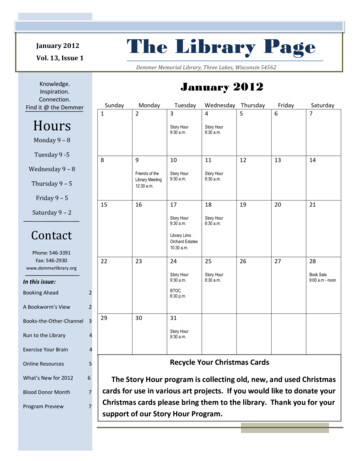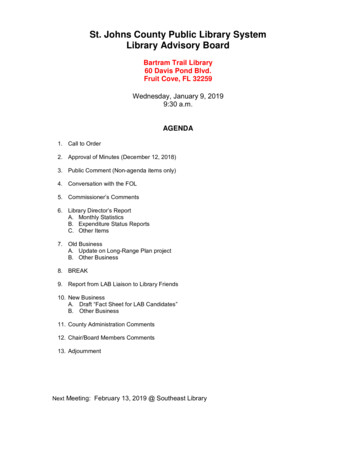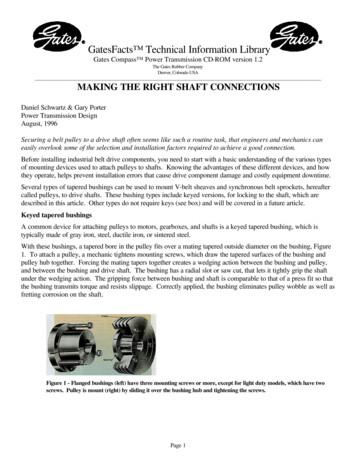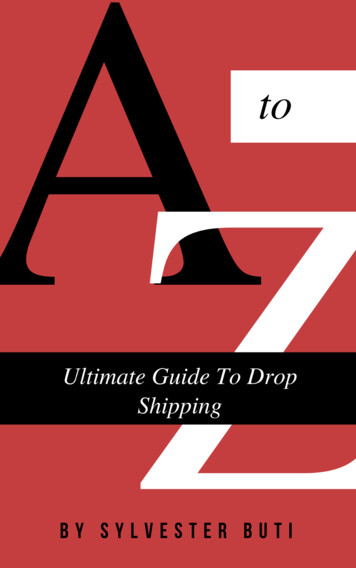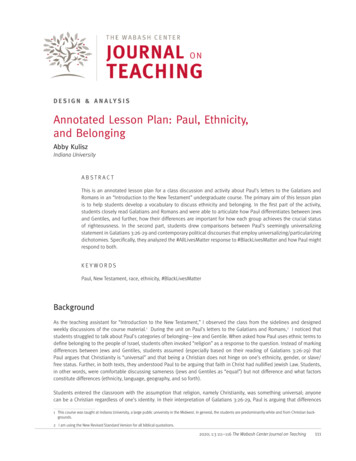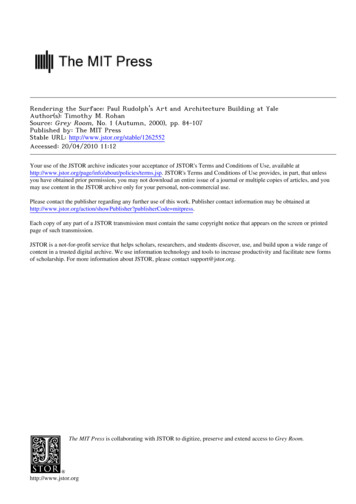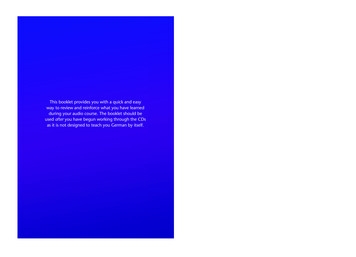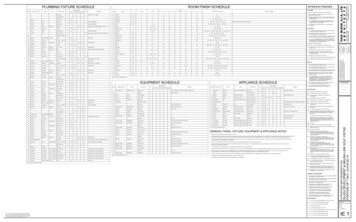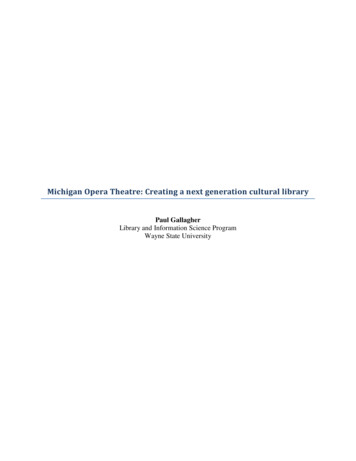
Transcription
Michigan Opera Theatre: Creating a next generation cultural libraryPaul GallagherLibrary and Information Science ProgramWayne State University
Page 1AbstractThe Allesee Dance and Opera Resource Library was founded in 2007 to serve as aresource center for dance and opera educational programs, and serve as the institutional archivesfor the Michigan Opera Theatre (MOT). The majority of its collection consists of archival items;recordings, videos, and ephemera related to past productions. The challenge to make thecollection more accessible is two-fold, providing the ability to search the materials, andproviding access to items- especially those in outdated formats. The current strategic vision forthe library consists of the following points, to digitize all possible archival materials, includingrecordings, photographs, videos, and paper items. Additionally, to make all digitized itemseasily searchable, and available online to the public. The current initiative is to digitize the entirecollection, and to integrate this rich historical collection with the performance history of theMOT. Issues such as technology, systems development, staffing, and digitization equipment arediscussed, along with internal practices on metadata and authority control. Specific software isdiscussed, as well as the ongoing PAST software to integrate archival materials and performancehistory. The MOT is staging itself to be a model for small cultural institutions, and to show thateven a minor repository can leverage existing technology and skills to better serve patrons.
Page 2ContentsAbstract . 1Introduction . 3Successful Examples . 4Digitization Practices . 7Data Systems . 8Archivists’ Toolkit . 9PAST – Performance Archive Search Tool . 10Koha . 12Koha & AT Integration . 13Volunteer Program . 13Conclusion . 14Appendix A – PAST Dates . 16Appendix B – PAST OPAC Search Interface. 17Appendix D – PAST Item Detail Page & Archival Viewer . 19Appendix E – PAST Name and Subject Browser . 20Appendix F – PAST Archival Browser . 21Appendix G – PAST Collection Browser . 22Appendix H – Volunteer Notice . 23Appendix J – Technology Resources . 24References . 25
Page 3Michigan Opera Theatre: Creating a next generation cultural libraryIntroductionThe Allesee Dance and Opera Resource Library was founded in 2007 to serve as aresource center for dance and opera educational programs, and serve as the institutional archivesfor the Michigan Opera Theatre (MOT). Initially funded by a large private donation, the libraryhas evolved from an undeveloped space into a functioning library, with the initial fundsproviding shelving, computers, and some library research materials. Serving as the cornerstoneof the new Ford Center for the Performing Arts, the MOT library provides and essential serviceto the community. “Opening the Ford Center for Arts and Learning is the realization of a dreamsome 35 years in the making,” said Dr. David DiChiera, Founder and General Director ofMichigan Opera Theatre. “I’ve always believed that education and outreach are an essentialcomponent of our work at Michigan Opera Theatre, and this new facility will allow us to expandour offerings, and touch even more lives with the arts.” (Michigan Opera Theatre).The majority of its collection consists of archival items; recordings, videos, and ephemerarelated to past productions. Additionally, there is a large collection of commercial items, such asdance books, classical recordings, and various operatic scores. Currently, the archival collectionis over one hundred archival boxes, with additional collections of recordings, videos, andperformance materials.The current challenge for the library is access to materials. The archival collection isextremely valuable not only for maintaining the history of the organization, and also containsimportant materials for the regular MOT operations. Photographs and videos are important tosupport the creative endeavors of future productions, and educational materials are important to
Page 4support the MOT’s educational initiatives. Many of the recordings are originals- and the onlysurviving copies, representing the entire audible history of the organization over a twenty yearspan.The challenge for to make the collection more accessible is two-fold, providing the abilityto search the materials, and providing access to items- especially those in outdated formats.While computers and related scanning equipment were purchased during the initial fundingstage, there was no fiscal provision for ILS systems or digitization software, and servicesprovided by local consortiums would present a large financial burden. To continue the missionof providing access, the library desired a plan of digitization to save archival items, as well asmake its collection available to the staff and public.The current strategic vision for the digitization initiative consists of the following points, todigitize all possible archival materials, including recordings, photographs, videos, and ephemera.Additionally, to make all digitized items easily searchable, and available online to the public andintegrate the performance history with the items, relating archival materials with informationabout performances. As with many performing arts collections, the ability to understandphotographs and recordings within the context of the performance is extremely important. Manyof the photos and recordings are of unknown performers, and while research materials exist toexplain the details, a data system combining performance information with archival items couldprovide a substantial research tool.Successful ExamplesFor a successful example, the MOT examined Metropolitan Opera and their onlinedatabase of performance history and archives. Written about by Anthony Tommasini in the NewYork Times, he states, “It's somehow fitting that the MET's sophisticated, user-friendly database
Page 5has finally opened up that sunless archive.” The MET system, while somewhat primitive in lightof more interactive search systems, generated considerable praise in their support of their history.In their initiative, the MET has created an online source of all known performances, andadditionally integrated digitized archival materials, notably photographs. Tommasini continues,Opera buffs everywhere are finding the database addictive. Mr. Tuggle has agrowing file of correspondence from appreciative users. Recently, an ominousletter arrived from one "Enzo Adorato," informing Mr. Tuggle that he was beingsued in a class action brought by employers across the United States for"wrongful interference with their employees' productivity" because of the Met'sengrossing database. Moreover, the letter continued, a separate class-action suitwas being filed against Mr. Tuggle and his database by neglected spouses,children and significant others for causing "alienation of affection" in their homes.Clearly the MET system presented an immense value to the institution, and the public, as well asgenerated additional traffic into the MET website. However, the MET initiative was build on topof the commercial InMagic system, and would not be applicable to the MOT in terms of cost andsupport. Additionally, the search functionality of the MET system is limited, results are at timesconfusing, and more powerful searches can only be conducted after reading extensivedocumentation. (Metropolitan Opera)In a related example, the Chicago Symphony Orchestra Rosenthal Archives provides a richcatalog of their archival items online. Named Theodore, the archives provides a full onlinesearch, allowing searching of their large collection. From their website, “Through a projectgenerously funded by the National Endowment for the Humanities, the majority of archivalholdings are now fully searchable via THEODORE, the online database of the RosenthalArchives. Included are corporate records, music manuscripts, selected photographs, and recordedsound and moving image collections.” (Chicago Symphony Orchestra) Build on top of theInMagic DB Text engine, it provides a similar functionality to the MET system. Additionally,the CSO provides much additional information about the archives on their website, showing the
Page 6importance of this activity to the organization. While the system provides a powerful glimpse ofthe their archival holdings, the system is not designed to serve as a digital asset managementtool, and has little support for working with digital surrogates. Digitized images are not displayedin the system, and there is no ability to understand the archival items in the context of aperformance. Additionally, the InMagic system is as much of a development tool as an archivalcatalog, and needs considerable configuration to implement. (InMagic)The MOT project, while similar in intent to the CSO and MET’s initiatives, needed to beconducted without additional cost to the institution. Beginning fall 2007, help arrived with theassistance of Wayne State University and the Institute of Museum and Library Services. As partof a two year grant named “Training the next generation fine and performing arts librarians,”select library and information science graduate students would be assigned to the library andarchives to help start the digitization, as well as assist in the physical construction. A publicitynotice from WSU states, “In addition to earning masters degrees in library and informationscience from Wayne State University, the recruits will receive practical training from mentors inbuilding and organizing a new library; managing an orchestra library; providing services in awell-established library; and providing services to faculty in an academic environment.”(WayneState University) The first thirty-week phase was centered on the physical construction of thelibrary, and processing the hundreds of boxes of both library and archival items.The current phase is to make items accessible, and to follow a plan of digitization to sharethe MOT collections. In order to providing access to the digital collections, three objectives areto be accomplished, creation of digitization practices, creation of an archival / digital assetmanagement system, and deployment of an ILS to support searching of more traditional libraryitems. Additionally, volunteers were needed to assist in the digitization and cataloging of the
Page 7library and archive. Following an education emphasis for both patrons and staffers, the MOT notonly provides resources for the performing arts, but also to help train library staff on thetechnical issues of digitization.Digitization PracticesCurrent digitization projects fall within three categories, audio, photographic, andephemeral digitization. Pictorial resources are digitized in one of two manners, either flatbedscanning or with slides and negatives, using an automated slide scanner. All equipment wascolor calibrated using a hardware calibration device, and both flatbed and slide scanners weretested with ISO 16067-1 Standard test targets. (Franziska) The inexpensive VueScan software isused for scanning, and all relevant settings are saved in profiles that can be quickly changed,making format changes a quick and automatic process. Scanning standards are based on Libraryof Congress specifications for digital imaging, which includes master scans varying from 300 –1200 ppi, at 24bit color or 8 bit grayscale. (Library of Congress) All files are saved inuncompressed TIFF format, with additional thumbnail and access images created via batchprocesses to support viewing in the archival online catalog (PAST OPAC, discussed below). Asthe future transferability of the images is critically important, file metadata is entered in theimages using Adobe Photoshop, and TIFF tagging is entered based on LC specifications.(Library of Congress) All digitized images automatically include technical metadata as afunction of the scanning software, and most descriptive metadata can be entered for entire imagegroups using Adobe Bridge.Audio resources are digitized using an M-Audio outboard soundcard and numerousaccommodations have been made to make the system as quiet as possible; including installing
Page 8dedicated ground lines to all equipment. Designed around parameters created by the HarvardUniversity “Sound Directions” program, recordings are captured at 256 kilobytes a second, jointstereo, and are saved in both archival wave (.WAV) and MP3 format. The Sound Directionsprogram, a joint venture between Harvard and the National Endowment for the Arts, providestools and standards for ongoing audio digitization programs. They state, “Sound archives havereached a critical point. Unique original materials are rapidly deteriorating, but prior to the initialphase of the project there were few published standards or best practices that addressed the postdigitization stages of archival audio preservation specifically.”(Harvard)The open-source audio recording software Audacity is used for the recording, as well asproviding editing and metadata creation tools. All recorded files have metadata that mirrorinformation entered in the archival catalog, providing for identification independent of thecatalog. Additionally, recordings are copied to CD, creating a CD duplicate that can be shelvedin the library collection and used by patrons and staff. Currently, the library has the capability todigitize most major formats, including Reel to Reel, Audio Cassette, DAT, and LP’s. Allrecorded files are archived in a centralized digital file repository; along will all other digital files.The digitization process currently generates about 3-5 gigabytes per performance, adds nearly adozen new items to the collection every week.Data SystemsThe data systems used for the MOT are three separate systems, two open source and acustom developed solution. The first system is the open source Archivists’ Toolkit, whichallows for the creation of encoded archival description (EAD) finding aids, and provides thebackbone support for creation of an archives database for both physical and digital items.
Page 9Second, is the Koha ILS system, which provides a catalog for non-archival library items, as wellas patron databases and future interlibrary loan partnerships. The third system, known as PASTor the Performance Archive Search Tool, allows for the creation of a performance historydatabase as well as search the archival collections, a feature previously unavailable with theArchivists’ Toolkit software.Archivists’ ToolkitThe Archivists Toolkit, or “AT” is freely available software for the creation of archivalfinding aids. It also allows for the creation of item level bibliographic records, as well as createsphysical and digital archival items, and can export records in many formats, including EAD,METS, MODS, MARCXML, and Dublin Core. As stated on the AT website,The Archivists’ Toolkit , or the AT, is the first open sourcearchival data management system to provide broad, integratedsupport for the management of archives. It is intended for a widerange of archival repositories. The main goals of the AT are tosupport archival processing and production of access instruments,promote data standardization, promote efficiency, and lowertraining costs.AT provides the main metadata tool for the archives, and provides an excellent tool tosupport standards compliant cataloging practices. Allowing easy creation of subject and nameauthority lists, it assists the user in with metadata entry with effective “tooltips” and substantialdocumentation. While AT presents a leap forward in archival cataloging software, thefunctionality is limited by its lack of a public interface, and the items recorded cannot be relatedto performance information. Simply stated, AT needed a web OPAC that could allow easysearching, as well as relate archival materials to performance information.
P a g e 10PAST – Performance Archive Search ToolPAST, or the Performance Archive Search Tool, is two separate pieces of software whichintegrate with data from Archivists Toolkit allowing the creation of a performance historydatabase as well providing an OPAC. Built on top of a previous version developed for theDetroit Symphony Orchestra, and exhibited at the 2007 Major Orchestra Librarians Association,PAST provides an innovative way to connect archives and past performances.The first component of PAST, PAST Dates, is a custom desktop application whichcaptures all relevant performance information, including dates, artists, and location. PAST Datesintegrates with the Archivists’ Toolkit underlying MySql database, uses the AT authority lists forprimary information. AT uses person names for the performers and subjects for opera titles;providing an easy means promote consistency between the archives and performance history.The system can show all photos of a performer, or their performances – a new method forintegrating archives and the performing arts. (Appendix A) The small PAST Dates applicationis simple to operate, and includes numerous enhancements to speed up data entry – such ascopying of performances and “suggested” entries to minimize typing. With fields for date,location, performers, roles, notes, and scanned programs, all necessary information about aperformance can be captured.The second component to the PAST system is the PAST OPAC, which allows searchingthe archival collections, as well as performance history and authority lists (Appendix C).Visitors can search using “suggested” searches, including wildcards, and get results in an easy toview paginated format. All results are clickable, which opens name, subject, or item detailpages. Archival items can be opened in a zoomable image viewer, allowing a closer examination
P a g e 11of archival items (Appendix D). Additionally, PAST allows searching by performances dates, orusers can
assistance of Wayne State University and the Institute of Museum and Library Services. As part of a two year grant named “Training the next generation fine and performing arts librarians,” select library and information science graduate students would be assigned to the library and



